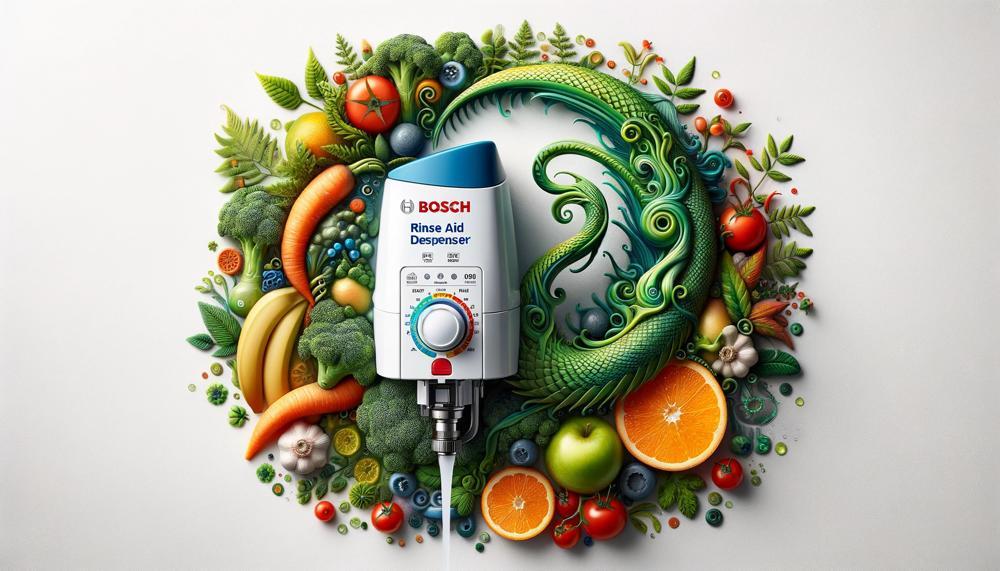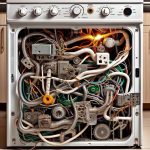Dishes that are supposed to come out sparkling clean, end up with pesky streaks and spots?
Sounds like your rinse aid dispenser may be the culprit. So, how to empty rinse aid dispenser bosch?
To empty a Bosch dishwasher rinse aid dispenser, you can try these steps:
- Open the dishwasher door to access the rinse aid dispenser
- Remove the dispenser cap
- Use a turkey baster to remove any old rinse aid or foreign substances
- Cleanse the dispenser tank with water until clear
- Fill the rinse aid dispenser tank with water and repeat until cleared
Let’s dive into our step-by-step guide on how to empty the rinse aid dispenser on a Bosch dishwasher.
Contents
How To Empty Rinse Aid Dispenser Bosch
Whether you are a seasoned DIYer or just beginning to delve into home maintenance, these straightforward steps will guarantee that your dishwasher remains efficient and effective.
Step 1: Uncover the Rinse Aid Dispenser
The first crucial step is to unlatch the rinse aid and gain access to the dispenser.
The location of this may vary based on your specific Bosch dishwasher model, but it typically resides on the dishwasher door. Keep the door open to ensure complete access to the dispenser.
Step 2: Eliminate Visible Debris
Utilize a cloth to eradicate any visible debris from the dispenser.
This will not only ensure that the rinse aid is fully emptied but also prevent any potential clogs or buildup in the future.
Step 3: Implement a Turkey Baster
A turkey baster can serve as a powerful tool for evenly removing the rinse aid from the dispenser.
Simply squeeze the bulb of the baster and release it over the compartment to suction up the rinse aid. This technique will prevent any unwanted spills or messes.
Step 4: Introduce Warm Water
If there is still residue lingering in the compartment, introduce warm water to help loosen any dried residue.
This will make it much easier for the turkey baster to remove it effectively.
Step 5: Repeat as Necessary
Continue this process until you are satisfied with the cleanliness of the compartment.
It may require a few attempts, but it is critical to be thorough in order to guarantee complete removal of all residue.
Step 6: Practice Patience and Take Your Time
It is crucial to practice patience and take your time throughout this process.
Hasty actions can result in mistakes and incomplete removal of the rinse aid.
How Do You Empty a Rinse Aid Dispenser?
If you are a passionate decorator and DIY enthusiast, you understand the significance of a spotless and effective dishwasher.
And for all the proud owners of Bosch dishwashers, we have got you covered with our comprehensive guide on emptying and cleaning your rinse aid dispenser.
Let us begin by gathering our materials. For this task, you will need a pair of rubber gloves, a large container, a funnel, and some paper towels or cloth. Now that we have all the necessary items, let us dive into the process.
- Step 1: Turn off your dishwasher. It is crucial to ensure that your dishwasher is completely powered down before attempting to access the rinse aid dispenser.
- Step 2: Locate the rinse aid dispenser. The exact placement may vary depending on your model, so be sure to consult your user manual for accurate instructions.
- Step 3: Remove the cap or lid. With caution, take off the cap or lid to access the rinse aid dispenser. Be gentle to avoid any spills or mishaps.
- Step 4: Empty the rinse aid. Gently tilt your dishwasher and use a funnel if necessary to pour the rinse aid into a large container. This will prevent any spills and make disposal easier.
- Step 5: Clean the dispenser. Once the dispenser is empty, it is time to give it a thorough cleaning. Use warm water and mild detergent to eliminate any buildup or residue inside the dispenser.
- Step 6: Rinse thoroughly. Ensure that you rinse the dispenser thoroughly with water to eliminate any remaining detergent or debris.
- Step 7: Dry the dispenser. Allow the dispenser to dry completely before replacing the cap or lid.
- Step 8: Refill with your preferred rinse aid product. Follow the instructions on the packaging for accurate measurements of rinse aid to use.
Can I Run a Bosch Dishwasher Without Rinse Aid?
Bosch dishwashers are renowned for their exceptional cleaning performance and efficiency. However, many people wonder if using rinse aid is necessary to achieve optimal results. As an expert on Bosch dishwashers, I am here to address the common question: Can I run a Bosch dishwasher without rinse aid?
The straightforward answer is yes, you can run a Bosch dishwasher without rinse aid, and the machine will still operate without any issues. However, before completely disregarding rinse aid, it is essential to consider a few things.
Why do manufacturers recommend the use of rinse aid in dishwashers? Rinse aid is a liquid additive that helps reduce water spots and improve drying performance. It works by breaking down the surface tension of the water, allowing it to effortlessly slide off the dishes, resulting in reduced water spots and faster drying times. This is especially beneficial for those with hard water, as it can cause mineral deposits and spots on dishes.

Now, let’s specifically discuss Bosch dishwashers. These machines are designed to deliver excellent results even without the use of rinse aid. This is because Bosch dishwashers have a built-in system that automatically adjusts the temperature and wash cycle duration based on the amount of food particles and dirt in the water. This means that even without rinse aid, your dishes will still come out clean.
However, not using rinse aid may result in longer drying cycles and water spots on your dishes, especially if you have hard water.
If you want your dishes to come out spotless and sparkling clean, then using rinse aid is recommended.
How Do I Know When My Rinse Aid Is Full?
You’ve invested in a top-of-the-line Bosch dishwasher, utilizing its advanced features to keep your dishes sparkling clean. But did you know that regular maintenance of the rinse aid dispenser is crucial for optimal performance? Neglecting this small but essential component can result in water spots and poor drying performance.
Here, we will walk you through the best method for emptying and cleaning the rinse aid dispenser in your Bosch dishwasher.
How Can I Tell When My Rinse Aid Dispenser is Full?
Before we dive into the cleaning process, it’s crucial to know when your rinse aid dispenser requires attention.
The indicator light on your dishwasher’s control panel will turn on when it’s time to empty and clean the dispenser.
Step 1: Gather Your Supplies
To properly clean the rinse aid dispenser, you will need a turkey baster, warm water, and a cloth or sponge.
Step 2: Empty the Dispenser
Start by opening the latch of the rinse aid compartment. Using a turkey baster, remove as much of the remaining rinse aid as possible.
This may require several attempts, so be patient and thorough.
Step 3: Add Warm Water
Once you have removed as much rinse aid as possible, pour warm water into the compartment. The warmth of the water will help loosen any dried-up residue.
Step 4: Repeat as Needed
Use the turkey baster to remove the warm water and any remaining residue from the compartment. Repeat this process until you are satisfied with the results.
Step 5: Wipe Down the Compartment
Using a cloth or sponge, wipe down the compartment to ensure it is free of any remaining residue.
Step 6: Let It Dry
Allow the compartment to dry completely before closing the latch and using the dishwasher again.
Can I Run a Bosch Dishwasher Without Rinse Aid?
The answer is affirmative, but as a connoisseur, I highly recommend utilizing this liquid additive for impeccable results. But before we delve into the details, let’s first comprehend what rinse aid is and why it is used. Rinse aid is a potent concoction that reduces spots and enhances drying in your dishwasher. It works by disintegrating the surface tension of water, allowing it to disperse evenly and preventing water droplets from forming on your dishes. The outcome? Sparkling dishes with minimal water spots.
However, you may argue that shiny dishes are not a priority; cleanliness is. While that may be true, using rinse aid also plays a vital role in the overall performance of your dishwasher. Without it, you may encounter spotty dishes and extended drying cycles. Furthermore, omitting rinse aid could potentially harm your appliance over time – a risk not worth taking.
So why do some individuals opt out of using rinse aid? Some believe that natural remedies such as white vinegar or lemon juice can achieve similar results without the added expense of a rinse aid product. Although these methods may suffice for some, they are not as efficient as a specialized rinse aid and could potentially damage the internal components of your dishwasher.
Now that we have established the significance of using rinse aid, let’s discuss how to properly maintain it in your Bosch dishwasher.
Regularly cleaning and emptying the rinse aid dispenser is crucial for optimal performance.
How Do I Know When My Rinse Aid Is Full?
Yet, with the plethora of household tasks to manage, it’s easy to overlook the rinse aid container. So, how do you determine when it’s time for a refill? Fear not, for we have you covered with this comprehensive guide on monitoring and refilling the rinse aid in your Bosch dishwasher.
First and foremost, fully open the dishwasher door to gain a clear view of the rinse aid container. It is typically located on the inside of the door, next to the detergent dispenser. The small cap bears a “Full” and “Empty” indicator.
Next, unscrew the cap and take a peek inside. If the container appears nearly full, then it’s time for a refill. But don’t fret; it’s an uncomplicated process.
To replenish the rinse aid dispenser, begin by opening its lid. Gently press down on the center of the lid with your thumb and lift up on the edge to open it. Then, carefully pour in the rinse aid until it reaches the “Full” marker.
Pro tip: Be cautious not to overfill as this may cause excessive sudsing and hinder your dishwasher’s efficiency.
If you accidentally spill some rinse aid, don’t panic. Simply use a damp cloth to clean it up before closing the lid.
Bosch dishwashers offer five diverse settings, ranging from 0 (no added rinse aid) to 4 (maximum rinse aid dosage). So if you notice that your dishes aren’t coming out as sparkling as you’d like, consider adjusting the intensity level.
Conclusion
In conclusion, maintaining a clean and efficient rinse aid dispenser is crucial for achieving spotless dishes with your Bosch dishwasher. Our step-by-step guide makes it easy to empty and clean the dispenser, ensuring optimal performance. Remember to take your time and be patient during this process for thoroughness.
But why is using rinse aid so important? Not only does it minimize water spots and enhance drying performance, but it also plays a vital role in your dishwasher’s overall function. While some may opt for natural alternatives, these can potentially harm your appliance over time. It’s best to stick with a specialized rinse aid product.
To know when it’s time for a refill, simply check the “Full” indicator on the dispenser’s lid. And don’t forget, you can adjust the intensity level of your rinse aid for even better results.





